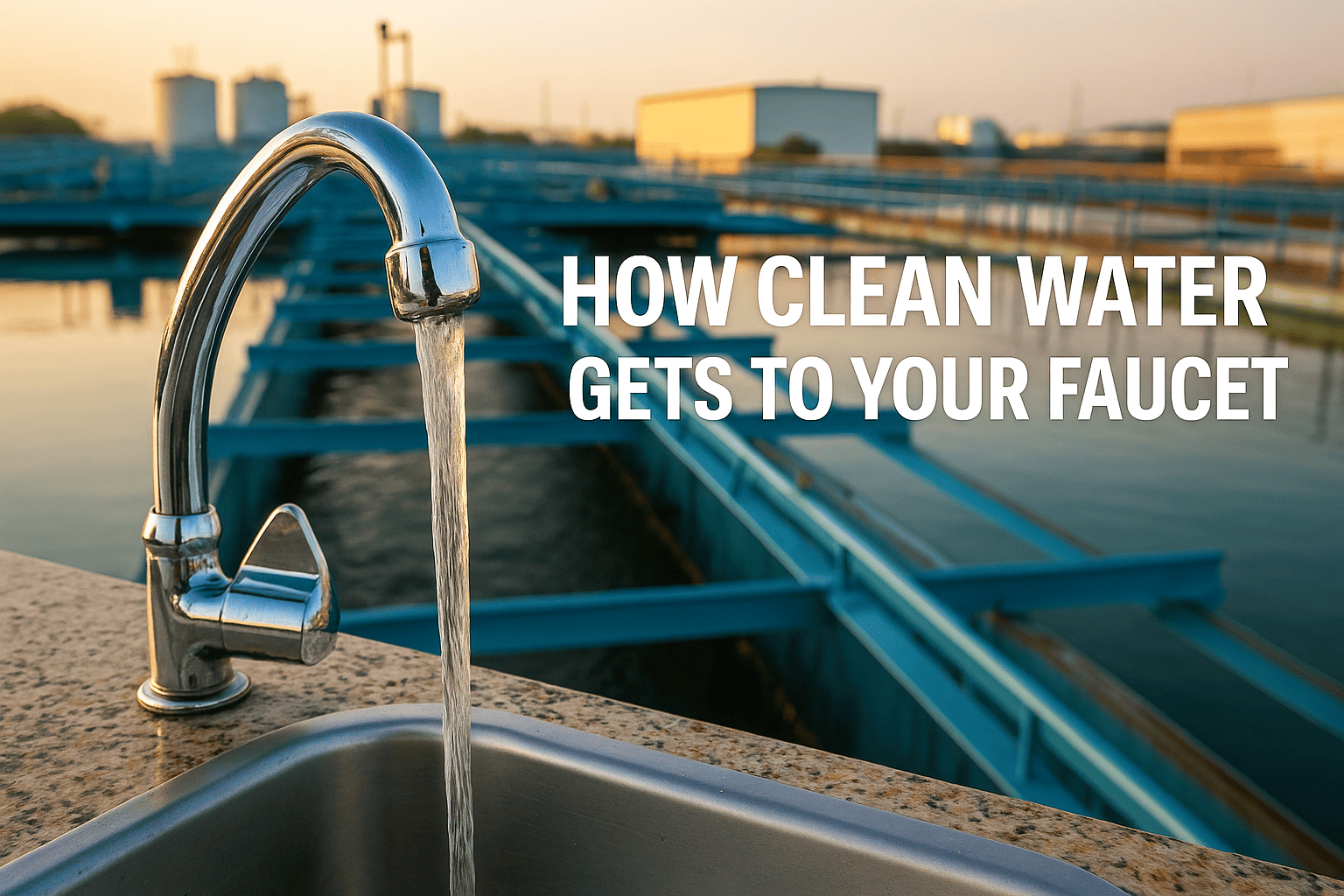When you twist your kitchen tap and hear the gush of water flowing into your glass or sink, it might feel like a small, everyday action. But behind that effortless stream lies one of the most complex and meticulously engineered systems in modern civilization. Clean water delivery is a triumph of infrastructure, public health, environmental engineering, and policy — and most people never think twice about how it works.
In this blog, we trace the invisible path water travels from natural sources to your faucet, revealing a vast network of pipes, filtration plants, sensors, and safeguards that make safe drinking water possible.
The Source: Where It All Begins
Most municipal water systems start with either surface water (like lakes, rivers, or reservoirs) or groundwater (from deep aquifers). In the U.S., about 61% of public water comes from surface sources, while 39% is drawn from underground wells.
Surface water is easier to access but more vulnerable to pollution. Groundwater, on the other hand, is naturally filtered through rock and soil, making it less prone to contamination but harder and costlier to extract.
Each city selects a water source based on geography, climate, population, and infrastructure budget. New York City, for example, sources 90% of its water from upstate reservoirs through gravity-fed aqueducts — an engineering marvel that transports water over 100 miles without pumps.
Step One: Pre-Treatment and Screening
The first step in the treatment process is to remove large debris — leaves, sticks, even fish — using screens or grates. At this stage, water is also tested for turbidity (cloudiness), pH level, and the presence of potentially harmful contaminants.
In some cases, a coagulant like alum is added to the water. This chemical causes fine particles to clump together into larger particles, called floc, that are easier to remove later in the process.
Step Two: Sedimentation and Filtration
Once coagulated, the water flows into a sedimentation basin where the floc settles to the bottom. This process mimics what would happen in nature over days — but it’s accelerated using engineering.
Next comes filtration. Water flows through layers of gravel, sand, and sometimes activated carbon. This step removes smaller particles, microorganisms, and certain chemicals. Some advanced systems even use membrane filters or reverse osmosis to purify water further.
Step Three: Disinfection — The Public Health Breakthrough
Disinfection is one of the most important stages. Chlorine is commonly used to kill pathogens like bacteria, viruses, and protozoa. Some systems use chloramine (a mix of chlorine and ammonia), ultraviolet (UV) light, or ozone as alternatives.
The addition of chlorine was one of the greatest public health achievements of the 20th century. Diseases like cholera and typhoid, once rampant in urban centers, plummeted with the widespread use of disinfected water.
Fluoride is also added to drinking water in many countries to promote dental health. This remains a controversial practice in some communities, though the CDC and WHO endorse it as safe and beneficial.
Storage and Distribution: The Underground Maze
Once treated, the water is stored in covered reservoirs or elevated tanks. These storage systems create water pressure — the force that propels water through the distribution network.
The distribution system itself is a vast underground web of pipes, valves, pumps, and meters. In many cities, these pipes stretch for hundreds or thousands of miles. In Los Angeles, for example, the water system covers more than 7,300 miles.
Water pressure must be carefully balanced. Too low, and users at higher elevations can’t access water. Too high, and it could burst old pipes. Engineers use pressure zones and booster stations to keep it just right.
The Role of Sensors and Monitoring
Modern water systems are equipped with digital sensors that constantly monitor water quality, pressure, and flow rate. These sensors can detect leaks, contamination, or usage spikes — and even trigger automated responses.
Water utilities also conduct regular manual testing. Field crews collect water samples from hydrants, fountains, and private residences to test for bacteria, lead, and other contaminants.
Protecting Public Health: Lead and Legionella
Two of the most well-known dangers in drinking water are lead and Legionella. Lead typically comes from old household plumbing, not the municipal source. To combat this, water is treated to form a protective coating inside pipes that prevents lead from leaching.
Legionella, a bacterium that causes Legionnaires’ disease, can thrive in warm, stagnant parts of building plumbing systems. That’s why building managers must regularly flush systems and monitor water temperature.
Climate Change and the Future of Water
Climate change is testing the resilience of water infrastructure. Droughts shrink reservoirs. Wildfires pollute watersheds. Intense storms overwhelm treatment plants.
In response, cities are exploring adaptive strategies:
- Desalination: Converting seawater into drinkable water using reverse osmosis.
- Water recycling: Treating wastewater to be reused for irrigation or even drinking.
- Smart meters: Giving consumers real-time data on usage to promote conservation.
Cape Town, South Africa, famously avoided “Day Zero” — the day its water supply was projected to run dry — through aggressive public campaigns and emergency planning. Their success is a model for other water-scarce regions.
What You Can Do
As a consumer, you can contribute to water sustainability and safety:
- Replace old pipes if your home was built before 1986.
- Install low-flow toilets and aerators.
- Fix leaks quickly — a dripping faucet can waste hundreds of gallons per year.
- Be mindful of lawn irrigation, especially in drought-prone areas.
Final Thoughts: A Modern Miracle
Water infrastructure is often invisible until something goes wrong. But every time you pour a glass of water, take a shower, or cook pasta, you’re benefiting from centuries of engineering progress and public policy. It’s a system we rely on every day — and yet rarely stop to appreciate. So the next time you turn the tap, take a moment. That clean stream of water is not just a utility. It’s a modern miracle.

